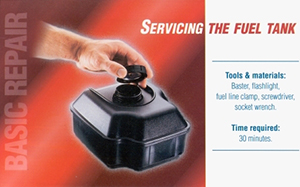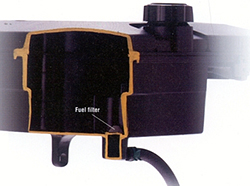How do I safely perform fuel tank cleaning for small engines?

Fuel tanks are designed to keep your engine's fuel clean, vented and secure on all lawn mowers, snow blowers and outdoor power products. If you spot debris in the gas tank or leaking gasoline, it's time for fuel tank maintenance. Never attempt to repair a damaged tank. It poses a risk of leakage, fire or fuel contamination. If you're replacing a fuel tank, use only parts recommended by the engine manufacturer. These parts will attach securely to your engine in the space provided.
Many fuel tanks are designed to use a vented gas cap to prevent a vacuum from forming in the fuel line. If fuel is leaking from the cap, a properly fitted replacement cap can solve the problem.
![]() WARNING: Always read the engine and equipment manual(s) before starting, operating, or servicing your engine or equipment to avoid personal injury or property damage. Fuel and its vapors are extremely flammable and explosive. Always handle fuel with extreme care.:
WARNING: Always read the engine and equipment manual(s) before starting, operating, or servicing your engine or equipment to avoid personal injury or property damage. Fuel and its vapors are extremely flammable and explosive. Always handle fuel with extreme care.:
See an authorized dealer or contact Briggs & Stratton if you are unsure of any procedure or have additional questions. Find all Engine Safety Warnings
Fuel Tank Parts

Fuel tanks must be constructed of a non corrosive material or coated with a corrosion-resistant layer to protect against the damaging effects of water, alcohol and salt. If the tank is designed to deliver fuel through a fuel line, a convex fuel filter may be located at the base of the tank, where fuel from the tank enters the fuel line. A filter can also be located outside the tank, midway along the fuel line.
If your tank must sustain excessive vibrations, you can install a labyrinth-equipped tank on some models. The labyrinth, available from your Briggs and Stratton Dealer, contains a set of baffles and/or a foam insert to reduce the sloshing and vaporization of fuel.
How to Clean a Fuel Tank in a Lawn Mower or Small Engine
1.Remove the spark plug lead and secure it away from the plug.
2.Use a fuel line clamp or other smooth-faced clamp to seal the fuel line where it attaches to the carburetor. Then, disconnect the line from the carburetor, hold the line over a bucket or fuel can and release the clamp. Dispose of all fuel in a safe manner.
3.Check with a flashlight for debris and beads of light that indicate holes or cracks. Use a baster to remove loose debris. If you find damage, replace the tank with original manufacturer's equipment.
4.Inspect the fuel filter for debris or deposits.
5.Reattach the fuel tank or install a new tank, fastening it firmly with the cap screws. This is a good opportunity to replace the fuel line and filter, using original manufacturer's equipment.
Service part numbers for the fuel tank are located in the small engine manual. It’s important to note that your engine parts list lookup typically requires the complete Model number and six character Type number. (Example: 12H702-0505-E1)
In order to view the correct Illustrated Parts List and determine the part numbers for your specific engine, you will need the engine type, model number and code number.




